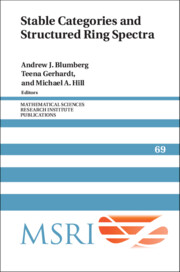Book contents
- Frontmatter
- Contents
- Contributors
- 1 Introduction
- 2 Homotopical categories: from model categories to (∞, 1)-categories
- 3 Stable categories and spectra via model categories
- 4 Stable homotopy theory via ∞-categories
- 5 Operads and operadic algebras in homotopy theory
- 6 Commutative ring spectra
- 7 An introduction to Bousfield localization
- 8 Spectral algebraic geometry
- Bibliography
- Index
6 - Commutative ring spectra
Published online by Cambridge University Press: 29 May 2025
- Frontmatter
- Contents
- Contributors
- 1 Introduction
- 2 Homotopical categories: from model categories to (∞, 1)-categories
- 3 Stable categories and spectra via model categories
- 4 Stable homotopy theory via ∞-categories
- 5 Operads and operadic algebras in homotopy theory
- 6 Commutative ring spectra
- 7 An introduction to Bousfield localization
- 8 Spectral algebraic geometry
- Bibliography
- Index
Summary
Since the 1990s we have had several symmetric monoidal categories of spectra at our disposal whose homotopy category is the stable homotopy category. The monoidal structure is usually denoted by ∧ and is called the smash product of spectra. So since then we can talk about commutative monoids in any of these categories — these are commutative ring spectra. Even before such symmetric monoidal categories were constructed, the consequences of their existence were described. In [296, §2] Friedhelm Waldhausen outlines the role of “rings up to homotopy”. He also coined the expression “brave new rings” in a 1988 talk at Northwestern University.
So what is the problem? Why don’t we just write down nice commutative models of our favorite homotopy types and be done with it? Why does it make sense to have a whole chapter about this topic?
In algebra, if someone tells you to check whether a given ring is commutative, you can sit down and check the axiom for commutativity and you should be fine. In stable homotopy theory the problem is more involved, since strict commutativity may only be satisfied by some preferred point set level model of the underlying associative ring spectrum and the operadic incarnation of commutativity is an extra structure rather than a condition.
There is one class of commutative ring spectra that is easy to construct. If you take singular cohomology with coefficients in a commutative ring R, then this is represented by the Eilenberg–Mac Lane spectrum HR and this can be represented by a commutative ring spectrum.
So it would be nice if we could have explicit models for other homotopy types that come naturally equipped with a commutative ring structure. Sometimes this is possible. If you are interested in real (or complex) vector bundles over your space, then you want to understand real (or complex) topological K-theory, and Michael Joachim [136, 137] for instance has produced explicit analytically flavored models for periodic real and complex topological K-theory with commutative ring structures.
There are a few general constructions that produce commutative ring spectra for you. For instance, the construction of Thom spectra often gives rise to commutative ring spectra. We will discuss this important class of examples in Section 6.4. A classical construction due to Graeme Segal also produces small nice models of commutative ring spectra (see Section 6.5).
Information
- Type
- Chapter
- Information
- Stable Categories and Structured Ring Spectra , pp. 249 - 300Publisher: Cambridge University PressPrint publication year: 2022
